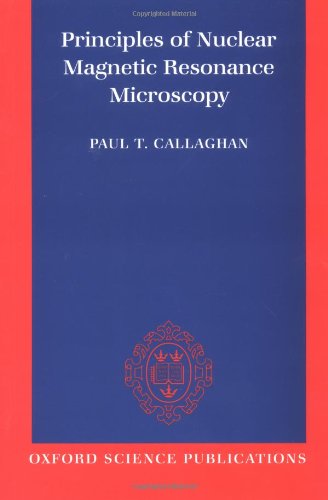Principles of Nuclear Magnetic Resonance Microscopy ebook
Par cowell wanda le lundi, avril 11 2016, 21:33 - Lien permanent
Principles of Nuclear Magnetic Resonance Microscopy. Paul Callaghan

Principles.of.Nuclear.Magnetic.Resonance.Microscopy.pdf
ISBN: 0198539444,9780198539445 | 512 pages | 13 Mb

Principles of Nuclear Magnetic Resonance Microscopy Paul Callaghan
Publisher: Oxford University Press, USA
This excellent introduction to the subject explores principles and common themes underlying two key variants of NMR microscopy, and provides many examples of their use. It has helped revolutionise “The NMR operates under the same principles as magnetic resonance imaging (MRI, which many patients experience as part of modern medical procedures) but is powered by a superconductor and has a magnetic field 400,000 times stronger than the Earth's magnetic field. Since light is nothing else than electromagnetic radiation, it seems a straightforward idea to use an approach similar to optical imaging in order to get spatially resolved NMR spectra. It means we can read it out with a microscope. �Nuclear magnetic resonance is a key technology for determining the structure of molecules and for visualising the anatomy of living tissue and microscopic structure. The structure determination of proteins by in-cell NMR spectroscopy opens new avenues to investigate at atomic resolution how proteins participate in biological processes in living systems. And how it's Smaller objects, such as viruses, or even molecules, are not visible in a microscope. Callaghan, Principles of Nuclear Magnetic Resonance Microscopy, Clarendon, Oxford, UK, 1991. In-cell NMR spectroscopy advances our understanding of . Le Bihan studied NMR imaging intensively and suggested that diffusional movements of water and other molecules inside the body could be used to visualize microscopic structure and function of the organs and tissues being observed with MRI. The principles and measurement techniques underlying Diffusion MRI are rooted in the classic formula proposed for Nuclear Magnetic Resonance (NMR) by E. A new form of NMR technology gives scientists what they need to examine the structure of minute samples. Magnetic resonance works by the interaction of electromagnetic radiation with the atomic nuclei in the presence of a magnetic field. Nuclear magnetic resonance imaging is best known for its spectacular use in medical tomography. Understand the physical principle of MR imaging 2. 4Center for Magnetic Resonance Research, Department of Radiology, University of Minnesota Medical School, 2021 Sixth Street SE, Minneapolis, MN 55455, USA 5Department of Electrical and Computer Engineering, University of Minnesota, 200 Union Street SE, P.
Food Chemicals Codex pdf download
The Strange World of Quantum Mechanics ebook
Fundamentals of Metal Fatigue Analysis ebook